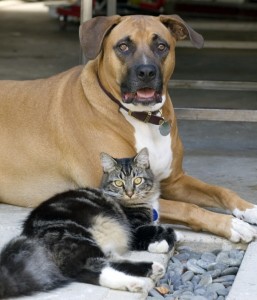
Unfortunately, when people introduce dogs to cats, the usual scenario is that the dog chases the cat, and the poor kitty ends up hiding in the basement, closet, or under the bed. This is unnecessary and not fair to either animal — especially your kitty. Your cat should not be relegated to the basement or spare bedroom.
As a general rule, your cat should have access to all the prime areas of the house and be invited to those areas regularly. Your kitty cannot be chased and your cat has to know that he or she is invited into all areas of the house. If you allow your dog to chase your cat, relegate your cat to the bedroom or basement, and just “hope” things work out, your dog will learn that it’s fun to chase your cat and your kitty will learn that you offer and provide no protection.
Below are helpful guidelines to follow to introduce a dog and cat to each other and to ensure that they have a harmonious, or at least, polite and well-mannered friendship. When you are not able to supervise, your dog and cat should be separated until you know they will behave well together.
If you have a dog who is fearful or timid, and a kitty who is territorial or aggressive, reverse some of these suggestions.
- To begin, designate a room or location in the house that is entirely your cat’s territory. Teach your dog that he is not allowed in this area.
- Your dog should not have access to litter boxes or to your cat’s food. In addition, your cat should not be forced to pass or dodge your dog to get to food and water bowls or litter pans. There should be more than one food bowl and at least a few bowls of water in a variety of locations for your kitty to choose from.
- Invest in a few good cat trees or cat condos. These provide your kitty with extra territory and will make your kitty feel safer.
- Always place your kitty on higher surfaces than your dog. This protects your cat and makes your kitty feel more confident. If your kitty is less likely to run, your dog will be less likely to chase.
- Use Feliway (synthetic pheromone) plug-ins to calm and soothe your kitty. Don’t plug in Feliway near water bowls, food or litter pans.
- If you frequently wear a perfume, cologne, or lotion, put some on your hands. When it dries, pet your animals. This way you can create a “communal” scent. Scent is very important to animals. If your dog and kitty smell similar to you and to each other, they may bond more quickly.
- Be sure to give your kitty plenty of attention.
- Exercise your dog before introducing him to your cat. If your dog has just run a few miles or played ball in the park for an hour, he will be a bit calmer, and hopefully a bit more relaxed. Do not introduce your dog to your cat if your dog has not had any exercise.
- Introduce your dog to your cat when your dog is tired, resting, or sleeping. This is also a good time to provide your dog with a chew toy, treat ball, or other food-dispensing toy. While your dog is sleeping or resting, feed your cat treats on the cat condo or sofa, or pet and brush your kitty on your lap. Do not bring your cat over to your dog and force or push an interaction.
- Use a front-clip body harness or head halter when introducing your dog to your cat, and make sure to have your dog on a leash. This will give you more control, and will prevent your dog from chasing your cat. Always keep the leash relaxed. If you feel your dog and cat are doing well together, keep the leash on your dog but don’t hold the other end. Let it drag behind him. This way you can lead him out of the room if you need to or prevent him from chasing.
- Feed your cat and dog extra good food and treats when they see each other and feed them meals at the same time. If your cat is afraid of your dog, feed them in separate rooms but so they can see each other. This establishes a positive association between them and gives them a reason to like each other.
- Reward your dog anytime he looks away from your cat.
- Teach your dog using positive reinforcement when your cat is in the room. This will teach your dog to listen to you and to behave when your cat is present. It’s also fun and rewarding for your dog.
- Alternate between treating and/or playing with your cat and treating your dog when they are in the same room together.
- Prevent your dog from chasing your cat by immediately interrupting your dog in a calm way. Redirect him to a more appropriate behavior, such as chewing on a toy, coming to you, or lying down.
- If your dog barks or lunges at your cat, remove him from the room temporarily. Treat and reward your kitty. Bring him back in and reward him for being calm, friendly, and gentle, and for ignoring your cat.
Copyright © Alana Stevenson 2012
Alana Stevenson provides phone & skype consults and can be contacted through her website AlanaStevenson.com. You can purchase a copy of a her book Training Your Dog the Humane Way on Amazon.

